What is the Rotator Cuff and What are its Functions?
The rotator cuff is a group of four muscles and their tendons that surround the shoulder joint and enable arm movement. These muscles (supraspinatus, infraspinatus, teres minor, and subscapularis) help keep the shoulder stable, while also allowing the arm to move up, to the side, and rotate. Most of our daily life activities, such as sports and lifting heavy objects, depend on the function of a healthy rotator cuff. This complex structure is one of the key elements that provides the shoulder with a wide range of motion.
What is a Rotator Cuff Tear and How Does It Occur?
A rotator cuff tear is a partial or complete injury to the tendons that connect the shoulder muscles to the bone. These tears usually occur for two main reasons: sudden trauma (e.g., a fall or accident) or age-related degeneration of the tendons. Professions that require repetitive shoulder movements (painters, carpenters) or sports (baseball, tennis) can also increase the risk of these tears. The size and type of the tear play a critical role in determining the treatment method.
What Are the Symptoms of a Rotator Cuff Tear?
The most common symptoms of a rotator cuff tear include shoulder pain, difficulty lifting the arm, and pain at night. The pain may worsen, especially when trying to lift the arm or when lying on the side. In some cases, a clicking or catching sound may be heard when moving the arm. A feeling of weakness in the shoulder can make even simple daily tasks (combing hair or getting dressed) difficult. The symptoms can worsen over time and seriously affect the quality of life.
When Is Rotator Cuff Surgery Necessary?
The decision for surgery is usually made when conservative treatments (physical therapy, painkillers, injections) fail and depending on the size of the tear. In cases of a full tear or a large partial tear, surgery may be inevitable. Additionally, surgical intervention may be recommended if the pain and weakness negatively affect daily life and the patient has an active lifestyle. The goal of the surgery is to repair the torn tendon and restore the function and strength of the shoulder.
What Are the Types of Rotator Cuff Surgery?
Rotator cuff surgeries can be performed using three main methods: open surgery, mini-open surgery, and arthroscopic (keyhole) surgery. Open surgery is a traditional method done with a large incision and is generally preferred for large tears. Mini-open surgery uses a smaller incision but still involves cutting some of the muscles. The most common and preferred method is arthroscopic surgery, which is performed using a camera and fine instruments inserted through small incisions. This method results in less tissue damage and faster recovery.
How Is Arthroscopic Rotator Cuff Repair Performed?
Arthroscopic rotator cuff repair is performed by using a camera and special surgical instruments inserted through a few small incisions (usually less than 1 cm) in the shoulder. The surgeon can see the inside of the shoulder joint in detail thanks to the camera view. The torn tendon is reattached to the bone using special sutures or anchors. This minimally invasive method offers less pain, a shorter hospital stay, and a faster recovery process.

How is the Cost of Rotator Cuff Surgery Determined in Turkey?
The cost of rotator cuff surgery in Turkey varies depending on many factors. The most important among these are the type of surgery (arthroscopic, open), the hospital’s location and technology, the surgeon’s experience, and the length of the hospital stay. The surgical materials used, anesthesia fees, and whether a post-operative physical therapy program is included also affect the total cost. Prices are usually offered as all-inclusive packages, which makes budget planning easier for patients.
Why is Turkey a Popular Destination for This Surgery?
Turkey has become a globally popular destination for rotator cuff surgery. The main reasons for this include the presence of modern hospitals with international accreditations like JCI, the existence of expert and experienced orthopedic surgeons in the field, and the provision of more affordable treatment options compared to Western countries. Additionally, patients are also provided with extra services such as airport transfers and accommodation during the treatment process.
How Do Prices in Turkey Compare to Other Countries?
The cost of rotator cuff surgery in Turkey is generally 50% to 70% lower than in the USA, Canada, UK, and other European countries. This price difference is due to the lower general cost of living in Turkey, lower operational expenses, and the exchange rate advantage. The lower prices do not mean a compromise in quality; many hospitals in Turkey provide services at international standards and with the latest technology equipment.
What Does the Surgery Package Usually Include?
The packages offered for rotator cuff surgery in Turkey usually include the surgery itself, the surgeon’s and anesthesia fees, the hospital stay (usually 1-2 nights), the first post-operative check-ups, and sometimes physical therapy sessions. Some clinics may also include additional services such as airport transfers and accommodation in the package. It is very important to find out exactly what the package covers before starting the treatment to avoid additional costs.
Can There Be Hidden Costs?
If the surgery package is not detailed, hidden costs may arise. Therefore, it is important to get the treatment plan and cost quotation clearly in writing. Additional costs may arise in situations such as extra tests that may be needed before the surgery, special implants used, or long-term physical therapy sessions. To prevent this, you should ask your clinic for an all-inclusive price quote before starting the treatment.
How to Choose a Surgeon and Clinic in Turkey?
When choosing a surgeon and clinic in Turkey, the most important criteria are the surgeon’s experience with rotator cuff surgeries, the clinic’s international accreditations (e.g., JCI), the technology used, and the reviews of former patients. You can make the right decision by examining the clinics’ websites online, reading patient reviews, and requesting an online consultation.
What Preparations Should I Make Before the Surgery?
The pre-operative preparation process varies according to your surgeon’s recommendations. Generally, you will be asked to stop using certain medications like blood thinners, painkillers, and some vitamin supplements. If you smoke, it is recommended to quit for a while before the surgery, as smoking can negatively affect the healing process. A general health check-up and necessary blood tests will also be performed before the surgery.
How Long Does the Surgery Take?
The duration of rotator cuff surgery varies depending on the size of the tear and the complexity of the repair. Generally, an arthroscopic surgery takes between 1 to 2 hours. However, in cases of large and complex tears or when additional procedures (e.g., biceps tendon repair) are needed, the surgery time may be extended. An experienced surgeon and a well-organized team manage this process in the most efficient way.
What Type of Anesthesia is Used?
Rotator cuff surgery is usually performed under general anesthesia, which ensures the patient is asleep throughout the entire surgery. In some cases, in addition to general anesthesia, regional anesthesia (nerve block) can also be used to facilitate post-operative pain management. The anesthesiologist determines the most suitable anesthesia plan by evaluating the patient’s general health condition.
How Long Is the Hospital Stay?
The hospital stay after arthroscopic rotator cuff repair is quite short. Patients are usually discharged on the day of the surgery or the next day. This period may be a few days longer for open or mini-open surgeries. The length of the hospital stay can vary depending on the patient’s general health condition and healing rate.
What is the Recovery Process Like After the Surgery?
The recovery process after surgery is a long one that requires patience and discipline. For the first few weeks, the arm is kept in a special sling. During this period, arm movement is limited. Then, the physical therapy process begins. Full recovery and regaining full shoulder strength can take from 6 months to 1 year. Adhering strictly to the physical therapy program is very important during the recovery process.
Is Post-Operative Physical Therapy Mandatory?
Yes, physical therapy after rotator cuff surgery is absolutely mandatory. Half of the success of the surgery depends on the surgery itself, and the other half depends on a good physical therapy program. Physical therapy helps increase the range of motion of the shoulder, regain muscle strength, and reduce pain. Regular exercises performed with a physical therapist ensure the shoulder returns to its normal function.
How Long Does the Physical Therapy Process Take?
The physical therapy process varies depending on the patient’s individual situation, the size of the tear, and the type of surgery. It can usually last from 3 to 6 months, and in some cases, it may take longer. In the first stages, passive movements are performed, while in the later stages, active exercises are transitioned to. The physical therapist regularly updates the program by evaluating the patient’s progress.
When Can I Go Back to Work?
The time to return to work depends on the type of job you have. If you have an office job, you can return to work 1-2 weeks after the surgery. However, if you work in a job that requires heavy physical activity, you may need to wait several months to fully recover and regain strength. This decision should be made together with your surgeon and physical therapist.
When Can I Return to Sports?
The process of returning to sports varies depending on the type of surgery and the intensity of the sport. For light sports like swimming, you can usually start after 3-4 months, while returning to sports that require intense shoulder movements like tennis or baseball can take from 6 months to 1 year. It is very important to strictly follow the advice of your physical therapist and surgeon during this process.
What Are the Possible Risks of the Surgery?
Rotator cuff surgery is a safe procedure when performed by an experienced surgeon, but like any surgical intervention, it carries some risks. These risks include infection, bleeding, anesthesia-related complications, shoulder stiffness, or a re-tear. These risks are explained in detail by your surgeon before the surgery, and the necessary precautions are taken.
What is the Success Rate of the Surgery?
The success rate of rotator cuff surgery is quite high, depending on the size of the tear, the patient’s age, and compliance with the post-operative physical therapy program. The success rate for small and medium-sized tears is over 90%. This rate may be slightly lower for large tears, but significant improvements in pain control and functionality are achieved.
How Is the Process Managed for Patients Coming from Abroad?
The process for patients coming from abroad usually begins with an online consultation. Patients send their existing MRI and medical reports to the clinic. The clinic evaluates these reports with an expert surgeon and presents a treatment plan and an estimated cost. When the patient arrives in Istanbul, the entire surgery and post-operative process (hospital stay, first check-ups) are pre-planned. Many clinics also provide support for airport transfers and accommodation.
Is Translation Service Provided?
Yes, many hospitals and clinics in Turkey offer translation services to facilitate the treatment process for international patients. Thanks to this service, the patient can communicate easily with the doctor and medical staff and get full information about the treatment process. The translation service is usually included in the surgery package.

How Should I Prepare for Travel to Turkey?
Before traveling to Turkey, you should check the validity of your travel documents such as your passport and visa. Also, you should contact the clinic to learn all the necessary preparations before the surgery (medication use, diet, etc.). It is generally recommended to arrive a few days before the surgery to have the final check-ups and rest.
Is the Treatment Covered by Insurance?
Whether rotator cuff surgery in Turkey is covered by insurance depends on the patient’s own health insurance policy. Some international private health insurance policies may cover treatments received abroad. It is important to confirm this with your insurance company in advance.
What Are the Post-Operative Care Recommendations?
The most important thing in post-operative care is to follow the instructions of your surgeon and physical therapist. Keeping your arm in a sling, regularly doing the recommended exercises, and avoiding heavy lifting are vital. Additionally, keeping the wound clean and dry reduces the risk of infection.
Does a Scar Remain After the Surgery?
In arthroscopic (keyhole) surgeries, a few small incision marks (approximately 1 cm) remain on the shoulder. These marks fade over time and become almost unnoticeable. In open surgeries, a larger scar may remain.
How Is Post-Operative Pain Managed?
Post-operative pain is usually controlled with medication. Painkillers are administered regularly during your hospital stay. After you are discharged, it is recommended to use the painkillers prescribed by your doctor regularly. Ice packs can also be used to relieve pain.
What Are the Differences Between Arthroscopic and Open Surgery?
Arthroscopic (keyhole) surgery involves smaller incisions, so muscle and tissue damage is minimal. This means less pain, less blood loss, and a shorter recovery time. Open surgery, on the other hand, requires a larger incision and is generally preferred for more comprehensive repairs.
What Is the Typical Age Range for the Surgery?
There is no specific age range for rotator cuff surgery. Although tears can occur at any age, they are more common in individuals aged 40 and over due to age-related degeneration. The decision of whether the surgery is suitable is based on the patient’s general health condition and lifestyle, not their age.
Can a Rotator Cuff Tear Heal Without Surgery?
Small and partial tears can heal without surgery with rest, physical therapy, and medication. However, large tears or full tears usually do not heal without surgery. In this case, delaying the surgery can cause the tear to enlarge and make the repair more difficult.
What Are the Non-Surgical Treatment Options?
Non-surgical treatment options include rest, using a sling to support the shoulder, painkiller medication, exercises performed with a physical therapist, and cortisone injections. These methods can be effective if the tear is small or if the patient is not suitable for surgery.
How to Prevent a Rotator Cuff Tear?
To prevent a rotator cuff tear, it is important to exercise regularly, strengthen the shoulder muscles, and increase their flexibility. It is also important to use correct techniques when lifting heavy objects, avoid repetitive movements, and avoid straining the shoulder.
What Is the Best Season for the Surgery?
The best season for rotator cuff surgery is the time when the patient will be most comfortable and can make the most efficient use of the recovery process. Patients generally prefer to have the surgery in the winter so they can rest comfortably in the warm weather. However, there are no medical restrictions.
What Is Done if the Tear Is Large?
If the tear is large and the tendon has retracted from the bone, the surgery may be more complex. In this case, the surgeon may use special suturing techniques or graft patches to repair the torn tendon. These surgeries can take longer depending on the size of the tear and the difficulty of the repair.
Can I Get a Second Opinion in Turkey?
Yes, many reputable clinics in Turkey offer patients coming from abroad the opportunity to get a second opinion based on their MRI results and medical reports. This allows the patient to get opinions from more than one expert and make the most informed decision before starting the treatment.
What is the Role of MRI in Diagnosis?
Magnetic Resonance Imaging (MRI) is the most important diagnostic method for determining the size, type, and location of a rotator cuff tear. MRI shows whether the tendon is torn, how large the tear is, and whether there are any other problems in the shoulder.
How Is the Decision for Surgery Made?
The decision for surgery is made by combining the patient’s complaints, physical examination findings, and MRI imaging results. If the pain and loss of function do not respond to conservative treatments and the tear is large, surgical intervention is usually the best option.


